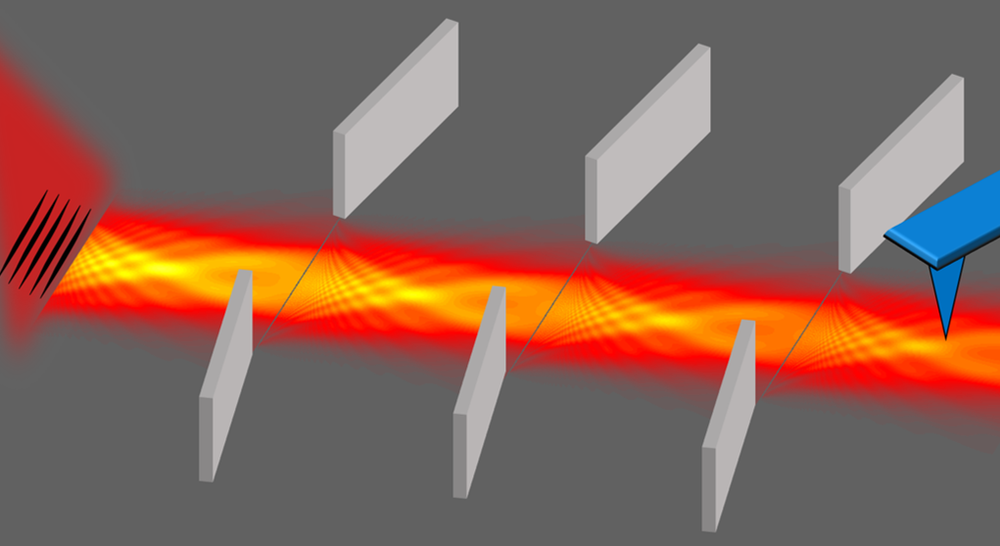Guiding Waves by Snipping Their Edges
Waves passing through a slit will normally spread out. But new experiments with plasmonic waves—combinations of light and electron oscillations—and with water waves show that a sequence of slits can confine waves along a narrow path [1]. The slits block the outer edges of the waves, while the unblocked portions concentrate toward the central axis of the waveguide as a result of interference effects. The simple slit-based design could be useful in situations where traditional waveguides are difficult to fabricate, such as in experiments with terahertz (far infrared) light waves.
Waveguides come in a variety of designs. A common form is a hollow metal pipe that can transmit radio waves or microwaves. At shorter wavelengths, a more effective approach is to use a fiber of dielectric material whose index of refraction is such that waves reflect at the outer shell of the fiber rather than escaping. In some cases, however, it is difficult to find a dielectric material with the necessary index of refraction.
Graduate student Dror Weisman from Tel Aviv University in Israel and his colleagues have developed a waveguide based on slits. “We don’t require any special material with a specific index of refraction,” Weisman says. “The only thing that we need is a material that blocks waves.” The idea is based on so-called diffractive focusing, in which waves passing through a slit form a narrow beam before diverging. This focusing is difficult to observe because it occurs close to the slit: for a slit having a width of roughly five wavelengths, the focusing occurs at a point about ten wavelengths away from the slit.
In a previous study of diffractive focusing, Weisman and his colleagues looked at waves propagating through two slits in series, with the second slit placed near the focal position of the first [2]. They noticed that when light passed through both slits, the diffraction pattern was similar to the diffraction pattern for one slit, suggesting that the process could be repeated with a third slit, a fourth slit, and so on. The team predicted that, with each slit focusing its output into the following slit, the series would act as a waveguide.
The researchers have now verified this prediction with two experiments. The first involved plasmonic waves, which are electromagnetic waves propagating along a metal surface and coupled to electrons in the metal. To make a slit-based plasmonic waveguide on a silver slab, the team fabricated pairs of thin, silver walls, with each pair separated by a gap of 14 micrometers. They tested waveguides having 2, 3, or 4 slits, with 40 micrometers between successive slits.
Using a laser, the team generated plasmonic beams with a wavelength of about 1 micrometer and probed the output of each waveguide with a near-field scanning optical microscope. They estimated that each slit caused around a 10% loss in plasmonic beam energy due to the cutting of the wave edges by the walls. In terms of loss per distance traveled, the slit waveguide was comparable to conventional plasmonic waveguides.
In a second experiment, the team tested the slit-based waveguide with water waves generated in a tank. Rather than passing the waves through a set of barriers (spatial slits), the researchers repeatedly operated their wave generator during short time windows (temporal slits). Each burst of waves “focused” into a narrow wave packet before spreading out in space and time. The team measured the wave packet’s shape near the focal point and fed the amplitude and phase data back into the wave generator to produce the next burst, removing the data falling outside of the time window. This iterative procedure kept the wave packet confined.
The slit-based waveguide is a general solution that should be applicable to all forms of waves, Weisman says. The technique could be practical for terahertz light, for which the existing waveguides often require composite structures that are complicated to manufacture. A slit-based terahertz waveguide would be easier to fabricate, which could be an advantage for long waveguides, Weisman says. Another advantage is that the slit sizes and positions are adjustable. For example, the team showed that shrinking the width of the slits allowed the waveguide to taper a beam, while shifting the slits’ positions could change the beam’s direction.
“This represents a new item in the toolbox of photonic device design,” says optics expert John Dudley from the University of Franche-Comté in France. “It is one of those wonderful papers that takes a seemingly well-known and basic concept of physics and applies it to develop a new functionality,” Dudley says.
–Michael Schirber
Michael Schirber is a Corresponding Editor for Physics Magazine based in Lyon, France.
References
- D. Weisman et al., “Diffractive guiding of waves by a periodic array of slits,” Phys. Rev. Lett. 127, 014303 (2021).
- D. Weisman et al., “Diffractive focusing of waves in time and in space,” Phys. Rev. Lett. 118, 154301 (2017).





